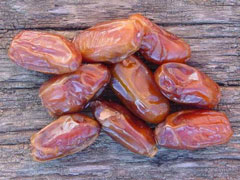


Home
Flowers &
Indoor Plants
Fruits & Nuts
Ornamentals
Vegetables
Special Topics
Resources
Glossary

|
Date Phoenix dactylifera (fee-nicks dack-til-if-er-ah)  Click on thumbnails for larger image. |
 |
What about it? Dates are the fruits of the date palm tree. Date Palms are members of the Palm family and are most closely related to grasses. It is said that they have been cultivated for over 5000 years! Date palm cultivation has spread throughout the semiarid and and subtropics, such as the Middle East and North Africa. The date palm was introduced to California and Arizona by the Spaniards a few centuries ago. The stately palm gets to be as tall as 100 feet, and is a symbol of warm, exotic places to those of us in the chilly north. It is a dioecious plant. What is it used for?Dates are eaten fresh or dried, and are a staple food in the Arabian diet. However, there are over 800 recorded uses of the date palm tree! Where does it grow? How do we grow it? Date palms require very hot and very dry weather. They also need a source of water and in many cases require irrigation. Rain will prevent pollination and therefore the production of fruit. They are propagated by "suckers" that are removed from the parent palm. Date palms generally begin to fruit at about 5 years. What are its primary problems? Smut, leaf spot, and brown rot can be problems for the date palm. How do we harvest and store it? The yellowish-brown fruits of the date pahn take 6 months to ripen. They can either be harvested while soft and moist, or allowed to remain on the tree till dry. Dates should be stored in a dry, warm area.
© Copyright, Department of Horticulture, Cornell University. |